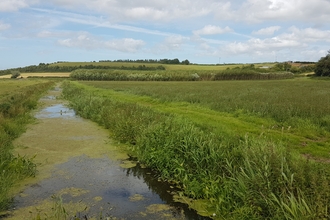
There are two stages of validation:
Project plan validation ideally takes place before restoration has begun. This is a review of the restoration plan suite of documents and the greenhouse gas assertion against the Peatland Code by an approved third-party independent validation body.
Restoration validation takes place within one year of finishing the initial restoration (the ‘start date’) and evaluates the restoration activities undertaken against the validated restoration plan. This is also carried out by an approved third-party independent validation body.
Project plan validation
Ideally, project plan validation should be in place before any restoration work starts, which might take anywhere between 3-12 months. If needed, however, restoration could start prior to completion of project plan validation. In this instance, the risk of not achieving project plan validation is for the project (no additional baseline evidence can be collected) and project plan validation should be achieved as soon as possible and before finishing the restoration.
Before any restoration takes place, a site survey to establish the baseline is required using the latest version of the Peatland Code Field Protocol as a guide. This survey is usually done by the people working on the project, but you can choose to hire an external consultant. This step can take place prior to registration or after.
When should I begin preparing for project plan validation?
This depends on when you plan for restoration to begin. Allow at least 1-3 months for document preparation and aim to submit to a validator at least 4-6 months before restoration is due to begin. (Please note project plan validation might not be completely achieved before restoration starts in this timeframe).
What documentation do I need for project plan validation?
To demonstrate compliance with the requirements of the Peatland Code, a number of actions and forms must be completed. The documents, available to download below, provide all the information required to carry out this step.
For all projects see Peatland Code Guidance and Field Protocol as additional documentation is required outside of the templates below.
Fens
- Peat Depth Template (fens)
- Management and Monitoring Plan Template
- Additionality Calculator
- Emissions Calculator (fens)
- Risk Assessment
- Project Design Document
- Landowner and Project Developer Commitment
- Environmental Registry Communications Agreement
Bogs
What happens once I have submitted my documentation to the validator?
The Validation body will engage with you or the project developer and review your documents. This is a process independent to the Peatland Code. Once the Validation body is satisfied the project is ready to be submitted for validation, the validator will send the documents to the Peatland Code team to review against the Peatland Code requirements.
Please note that this is an extra check that all Peatland Code requirements are indeed adhered to. It is required to make sure different validations bodies are validating to the same level of scrutiny, This is not a full review of the documents.
Once the Peatland Code team is satisfied the project meets the Peatland Code requirements, the validation gets approved and the validator produces a validation opinion statement, which is valid for 3 years.
All documents are then submitted to the UK Land Carbon Registry and the project is marked as ‘validated’. Projects can choose to have their Pending Issuance Units (PIUs) issued at this point or at Restoration Validation we strongly encourage projects to wait till Restoration validation.
Restoration validation
Within one year of finishing the restoration activities detailed in the validated project design document, the project must arrange an independent validation/verification body to assess the restoration work on site. This validation of the restoration activity will check if the project has delivered the planned restoration work against the validated project plan and adjust the expected emission reductions if necessary.
What documents to I need for restoration validation?
The project must submit a final restoration report to the validator outlining which restoration activities were carried out, including evidence of this, and cross referencing with the validated restoration plan. Further information on this report can be found in the Peatland Code Guidance document.
If the implemented restoration differed from the restoration plan submitted at project plan validation, all relevant documents need to be updated and resubmitted during restoration validation. If necessary, an adjustment to the amount of Pending Issuance Units (PIUs) issued will be made.
A ‘restoration validation’ opinion statement is then awarded, stating the amount of expected emission reductions and the corresponding number of PIUs. If PIUs were issued before restoration commenced, these can be adjusted according to the restoration validation certificate. The restoration validation statement is valid until the year 5 verification is due.
Validation/verification bodies
All Peatland Code projects must be independently validated and verified. Only an approved validation/verification body is permitted to carry out Peatland Code validation and verification.
How do I contact a validator?
There are currently two approved organisations that can validate and verify Peatland Code projects:
You will need to contact an appointed validation body to carry out your project validation. This is a paid service - for quotes please contact the validation bodies directly.
Upon application, a date to conduct audit of both the project site and the project documentation will be arranged. Amendments to the project plan may be required if determined necessary by the validation/verification body to ensure compliance with the Peatland Code.
Do I have to use the same validation/verification body all the way through the Peatland Code process?
No, you may switch in between the project plan, restoration validation and verification stages if you choose to.





